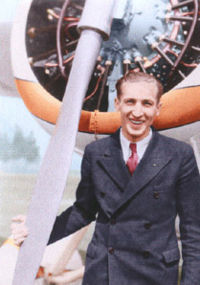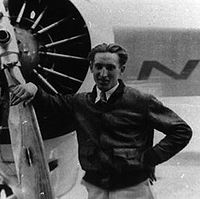
Feliksas Vaitkus
Encyclopedia



United States
The United States of America is a federal constitutional republic comprising fifty states and a federal district...
born Lithuanan pilot and the sixth pilot to fly solo across the Atlantic.
Biography
His parents came from LithuaniaLithuania
Lithuania , officially the Republic of Lithuania is a country in Northern Europe, the biggest of the three Baltic states. It is situated along the southeastern shore of the Baltic Sea, whereby to the west lie Sweden and Denmark...
in 1904, settling in the old "Lithuanian Downtown" in Chicago's Bridgeport
Bridgeport, Chicago
Bridgeport, one of 77 community areas of Chicago, is a neighborhood located on the city's South Side. It is bounded, generally, on the west and north by the Chicago River, on the east by Canal Street, and on the south by Pershing Road.-History:...
neighborhood where Vaitkus was born three years later. He enlisted in the army in 1928, and after graduating from advanced pilot’s training school, was commissioned a second lieutenant in the Air Corps. In 1931, he was placed in the reserves with the rank of first lieutenant and returned to civilian life to work with his father-in-law who operated a flying school in Kohler, Wisconsin
Kohler, Wisconsin
Kohler is a village in Sheboygan County, Wisconsin, United States, along the Sheboygan River. The population was 1,926 at the 2000 census. It is included in the Sheboygan, Wisconsin Metropolitan Statistical Area.-Geography:...
.
Lituanica II
A few months after the LituanicaLituanica
Lituanica was an Bellanca CH-300 Pacemaker airplane flown from the United States across the Atlantic Ocean by Lithuanian-American pilots Steponas Darius and Stasys Girėnas in 1933...
tragedy, some prominent members of the Chicago Lithuanian community discussed the possibility of financing another transatlantic flight. This idea was greeted with much enthusiasm, and enough funds were raised during this difficult period, which was called the Great Depression
Great Depression
The Great Depression was a severe worldwide economic depression in the decade preceding World War II. The timing of the Great Depression varied across nations, but in most countries it started in about 1929 and lasted until the late 1930s or early 1940s...
. A much faster and more modern aircraft (compared to the original Lituanica) was purchased from the Lockheed Aircraft Corp., called the Lockheed Vega
Lockheed Vega
|-See also:-References:NotesCitationsBibliography* Allen, Richard Sanders. Revolution in the Sky: Those Fabulous Lockheeds, The Pilots Who Flew Them. Brattleboro, Vermont: The Stephen Greene Press, 1964....
, the same model used by Wiley Post
Wiley Post
Wiley Hardeman Post was a famed American aviator, the first pilot to fly solo around the world. Also known for his work in high altitude flying, Post helped develop one of the first pressure suits. His Lockheed Vega aircraft, the Winnie Mae, was on display at the National Air and Space Museum's...
in his round-the-world flight, and by Amelia Earhart
Amelia Earhart
Amelia Mary Earhart was a noted American aviation pioneer and author. Earhart was the first woman to receive the U.S. Distinguished Flying Cross, awarded for becoming the first aviatrix to fly solo across the Atlantic Ocean...
, the first woman to fly solo across the Atlantic.
The aircraft was christened Lituanica II on Sunday, April 22, 1934. When the pilot originally chosen for the flight unexpectedly resigned in the spring, the Lithuanian organizers turned to Felix Waitkus, and he accepted the challenge to fly to Lithuania.
The original flight date had to be changed to 1935 because modifications were needed to strengthen the aircraft's structure due to the installation of extra fuel tanks and a more powerful engine. New equipment was added, which Darius and Girėnas
Lituanica
Lituanica was an Bellanca CH-300 Pacemaker airplane flown from the United States across the Atlantic Ocean by Lithuanian-American pilots Steponas Darius and Stasys Girėnas in 1933...
did not have, such as a variable pitch propeller to improve engine performance and a radio compass. Lituanica II was flown extensively to insure its success.
The Flight
Waitkus arrived at Floyd Bennett FieldFloyd Bennett Field
Floyd Bennett Field is New York City's first municipal airport. While no longer used as an operational commercial, military or general aviation airfield, the New York Police Department still flies its helicopters from its heliport base there...
in New York in May 1935. Up until then, no pilots were able to fly over the Atlantic due to poor weather conditions, and so he had to wait until the chief meteorologist gave him a favorable weather report. It was not until four months later, on the evening of September 20, he was informed that the weather along his route had improved where conditions were average with no major changes expected in the next 24 hours. Encouraged with this news, Waitkus decided to fly.
The next day, September 21, at 6:45 in the morning, Lituanica II was headed for Europe. Unfortunately, Waitkus had to fight the worst possible weather conditions, flying through rain, fog, and icing conditions, so that most of his navigation had to be by his new radio compass. More than once he noticed ice forming on the wings and had to descend to a lower altitude until it all thawed off. Waitkus was helped considerably by hourly broadcasts from an Irish radio station. He learned that Dublin was fogged in, as well as all areas heading east as far as the Baltic Sea
Baltic Sea
The Baltic Sea is a brackish mediterranean sea located in Northern Europe, from 53°N to 66°N latitude and from 20°E to 26°E longitude. It is bounded by the Scandinavian Peninsula, the mainland of Europe, and the Danish islands. It drains into the Kattegat by way of the Øresund, the Great Belt and...
. He knew that he could not make it to Kaunas
Kaunas
Kaunas is the second-largest city in Lithuania and has historically been a leading centre of Lithuanian economic, academic, and cultural life. Kaunas was the biggest city and the center of a powiat in Trakai Voivodeship of the Grand Duchy of Lithuania since 1413. During Russian Empire occupation...
due to his low fuel supply, and being exhausted after a 23-hour struggle fighting the elements, he felt it was best to come down somewhere in Ireland.
He spotted an open field in Cloongowla at Ballinrobe
Ballinrobe
-Early history:Dating back to 1390, Ballinrobe is said to be the oldest town in South Mayo. The registry of the Dominican friary of Athenry mentions the monastery de Roba, an Augustinian friary whose recently restored ruins are one of the historical landmarks of the town today...
, County Mayo
County Mayo
County Mayo is a county in Ireland. It is located in the West Region and is also part of the province of Connacht. It is named after the village of Mayo, which is now generally known as Mayo Abbey. Mayo County Council is the local authority for the county. The population of the county is 130,552...
and came down, with the aircraft suffering extensive damage . He was lucky to be alive without suffering any injuries. Lituanica II was crated for shipment to Lithuania, where it would be restored. By ship and by train he made his way to Kaunas where he was given a hero’s welcome.
The only one to fly across the North Atlantic in 1935 was Felix Waitkus, and even though he came down in Ireland and not in Kaunas, he was entered in aviation’s history books for being the sixth pilot to fly solo across the Atlantic.
He was recalled to active duty in the Army Air Corps in 1940, serving as the chief test pilot at the Boeing Aircraft Co. in Seattle, testing hundreds of B-17 and B-29 bombers. He was recalled again to serve in the U.S. Air Force during the Korean War
Korean War
The Korean War was a conventional war between South Korea, supported by the United Nations, and North Korea, supported by the People's Republic of China , with military material aid from the Soviet Union...
.
He died of a heart attack while stationed at Wiesbaden
Wiesbaden
Wiesbaden is a city in southwest Germany and the capital of the federal state of Hesse. It has about 275,400 inhabitants, plus approximately 10,000 United States citizens...
, Germany
Germany
Germany , officially the Federal Republic of Germany , is a federal parliamentary republic in Europe. The country consists of 16 states while the capital and largest city is Berlin. Germany covers an area of 357,021 km2 and has a largely temperate seasonal climate...
on July 25, 1956 at the age of 49. His body was shipped home and interred in his wife’s family plot in the Kohler Cemetery at Sheboygan, Wisconsin
Sheboygan, Wisconsin
-Airport:Sheboygan is served by the Sheboygan County Memorial Airport, which is located several miles from the city.-Roads:Interstate 43 is the primary north-south transportation route into Sheboygan, and forms the west boundary of the city. U.S...
. At the time of his passing he held the rank of lieutenant Colonel.

